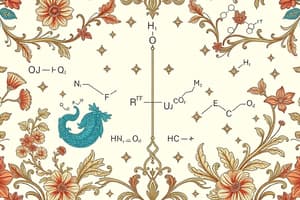Podcast
Questions and Answers
What type of reaction is the equation 2Fe2O3 + 2Al → Al2O3 + 2Fe an example of?
What type of reaction is the equation 2Fe2O3 + 2Al → Al2O3 + 2Fe an example of?
- Combination reaction
- Double displacement reaction (correct)
- Decomposition reaction
- Displacement reaction
What is the result of a combination reaction?
What is the result of a combination reaction?
- The formation of two or more products
- The decomposition of a single reactant
- The combination of two or more reactants (correct)
- The replacement of one element with another
Which of the following reactions is an example of a combination reaction?
Which of the following reactions is an example of a combination reaction?
- H2 + O2 → 2H2O (correct)
- CaO + H2O → Ca(OH)2
- Na + Cl2 → 2NaCl
- Fe + O2 → Fe2O3
What is the purpose of balancing a chemical equation?
What is the purpose of balancing a chemical equation?
What is the result of the reaction between hydrogen gas and nitrogen?
What is the result of the reaction between hydrogen gas and nitrogen?
What is the result of the reaction between hydrogen sulphide gas and oxygen?
What is the result of the reaction between hydrogen sulphide gas and oxygen?
What is the result of the reaction between barium chloride and aluminium sulphate?
What is the result of the reaction between barium chloride and aluminium sulphate?
What is the result of the reaction between potassium metal and water?
What is the result of the reaction between potassium metal and water?
What type of reaction is the equation Ca(OH)2 + H2SO4 → CaSO4 + 2H2O an example of?
What type of reaction is the equation Ca(OH)2 + H2SO4 → CaSO4 + 2H2O an example of?
What is the result of the reaction between calcium hydroxide and carbon dioxide?
What is the result of the reaction between calcium hydroxide and carbon dioxide?
Flashcards are hidden until you start studying
Study Notes
Combination Reactions
- A reaction in which a single product is formed from two or more reactants is known as a combination reaction.
- Examples of combination reactions include the reaction of calcium hydroxide with carbon dioxide to form calcium carbonate, the burning of coal, and the formation of water from hydrogen and oxygen.
Exothermic Reactions
- Reactions that release heat along with the formation of products are called exothermic reactions.
- Examples of exothermic reactions include the burning of natural gas, respiration, and combination reactions.
Different Types of Reactions
- Decomposition reactions are the opposite of combination reactions, where a single reactant breaks down into two or more products.
- Displacement reactions involve the replacement of one element by another in a compound.
- Double displacement reactions involve the exchange of partners between two compounds.
- Precipitation reactions involve the formation of an insoluble solid (precipitate) from a solution.
Oxidation and Reduction
- Oxidation is the gain of oxygen, while reduction is the loss of oxygen.
- Examples of oxidation include the reaction of carbon with oxygen to form carbon dioxide, and the reaction of zinc with oxygen to form zinc oxide.
- Examples of reduction include the reaction of lead oxide with hydrogen to form lead and water.
Corrosion and Rancidity
- Corrosion is the reaction of a metal with oxygen and moisture to form a compound that damages the metal.
- Rancidity is the process of oxidation of oils and fats, leading to their spoilage.
Balancing Chemical Equations
- A balanced chemical equation is one in which the number of atoms of each element is the same on both the reactant and product sides.
- Chemical equations should be balanced to ensure that they accurately represent the chemical reaction.
- Examples of balanced chemical equations include the reaction of hydrogen with nitrogen to form ammonia, and the reaction of barium chloride with aluminium sulphate to form aluminium chloride and barium sulphate.
Studying That Suits You
Use AI to generate personalized quizzes and flashcards to suit your learning preferences.




